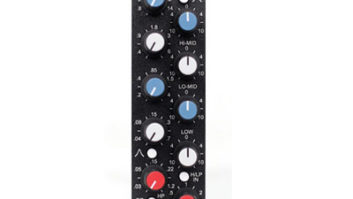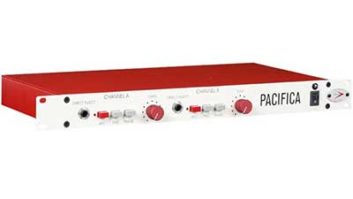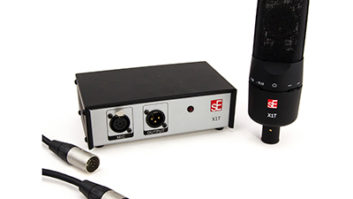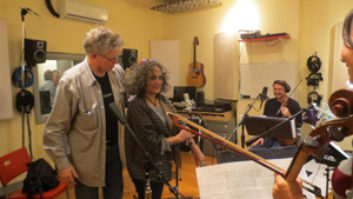Most electronic designers strive to create the most accurate and transparent circuitry possible. In a way, digitized audio is the result of such pursuits, yet the negative reactions forced many designers to reinvestigate the process. Is “ye olde stuff” really better? The answers are complex, but analog’s idiosyncrasies are what everyone raves about. Realizing that recording engineers need a full-spectrum sonic palette, Great River designer Dan Kennedy went against his instincts of “accuracy first.” True, there are times when transparent-clean is the best and only choice. Other times, a little grunge helps bring a more aggressive “street” feel to overly sterile studio tracks, especially now that analog tape has become more a piece of outboard than a standard part of the recording process.
Just as there is more than one way to skin the proverbial cat, Great River’s MP-2NV stereo mic preamp takes a highly divergent path to achieve sonic nirvana. Different from other Great River or Neve 1073-based products, the MP-2NV was inspired by the ever-colorful Fletcher of Boston-based Mercenary Audio, with several key features increasing the unit’s sonic options and flexibility.
ENTER THE MP-2NV
Listing at $2,499, this stereo unit is housed in a single-rackspace chassis, with transformer-balanced mic inputs on the rear and ¼-inch hi-Z (1-megohm) unbalanced instrument inputs on the front face. Each channel has individual rotary-input gain switches, output level pots, and switches for output termination, polarity reverse, phantom power and mic input impedance. Outputs are 600-ohm, transformer-balanced, line-level XLRs (maximum output level +27 dBm, terminated) with unbalanced TRS inserts between preamp, and output amplifiers for outboard such as compression and equalizers.
A traditional Neve module has a rotary switch for coarse gain with a console fader to trim the gain. (The switch actually dials-in various combinations of amplifier stages, gain and input transformer attenuation.) The MP-2NV includes an output stage level pot and metering for both stages. Input gain for the MP-2NV is in 5dB steps, output gain is continuously variable from -20 dB through unity to +10 dB. It is possible to purposely run the preamp hotter than the output amp, or vice versa.
I found this extremely helpful when recording drums, placing a pair of Marshall MXL-2003 large-diaphragm condensers in an X-Y configuration about three feet from the kit and allowing 4 to 6 dB of headroom. Drummers’ repeated “overs” occurred when going from verse to chorus. I turned down the output gain to minimum, cranked up the input gain — again allowing 4 to 6 dB of headroom, only this time there were no “overs” — and, there was no sign of undesirable distortion, with drums at least. How cool is that?
What makes these Class-A Neve circuits special is that when driven with hot transients, they behave just like peak limiters. There is even a dynamic recovery time, although that is not easy to show in print. You can see what happens to “static” sine waves in Fig. 1a. Note that each stage behaves similarly, clipping only half the wave first. Modern op amps clip symmetrically. In Fig. 1b, the third-octave display of the NTI Minilyzer indicates not only the second harmonic, but also a cluster of harmonics starting with the third.
Most people purposely abuse Neve gear, but these circuits have plenty of headroom, and the MP-2NV easily has 15 to 20 dB less noise than its vintage ancestor does. By consolidating all the plug-in cards onto one circuit board and using low-noise components throughout, the signal-to-noise ratio is in excess of 105 dB at 30dB gain and 96 dB at 60dB gain, unweighted.
GOING DIRECT
A traditional mic pre/active DI connects the instrument directly to the first amplifier, bypassing the input transformer. Fletcher insisted on using the input transformer for additional color, and, as unconventional as that might be, Dan Kennedy’s solution was to put a FET impedance converter in front of it.
Even my humble Univox P-Bass copy sounded surprisingly round through the direct input. It was not clangy, nor was there a silly amount of unnecessary subsonic disturbance. Although there’s no metering to indicate FET overload, doing so is pretty obvious. I simply turned the level control down on the bass. Again, manipulating the input and output gain controls can massage the tone range, which is enhanced with a good technique and consistent touch.
To further trick out the MP-2NV, the input transformer has multiple windings, just like the Neve modules, but now the input impedance switch — with 50/200-ohm options — is on the front panel. This is cool if you have ribbon mics, plus the 50-ohm setting loads the FET for a different sound.
Output termination rounds out the options. Many people — accidentally or not — run the Neve modules un-terminated, resulting in a brighter sound from transformer ringing. (See Fig. 2.) By placing the option on the front panel, users can run either way and not have to futz with resistors, or ever have to go to the rear panel for anything other than input, output, insert and power connections.
The Great River MP-2NV combines a recording engineer’s needs with a design engineer’s creative circuitry. The result is a more flexible preamp that provides the classic sonic airbag protection, especially on drums, for which vintage Neve Modules are well-known. There is plenty of gain and less noise than the vintage originals, well-suited for delicate acoustic work even when using a ribbon mic. Offering a remarkable level of sonic versatility plus ease of use, the MP-2NV is a sonic crayon that can paint a whole rainbow.
Great River Electronics, 3056 East 65th St., Inver Grove Heights, MN 55076; 651/455-1846; fax 651/455-3224; www.greatriverelectronics.com.







